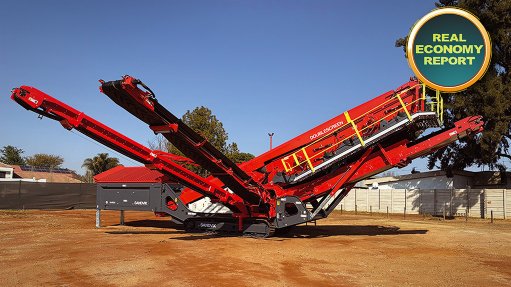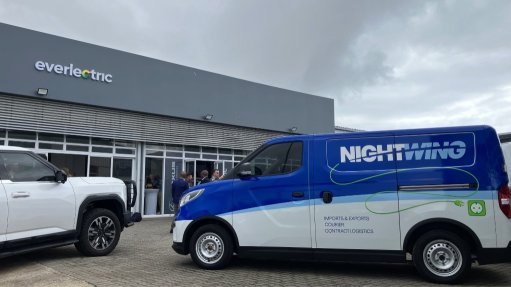Free app enables facility managers to view LED lighting savings
A free smart device app and Web-based tool has been developed to enable anyone in South Africa to measure how much energy, cost and greenhouse-gas emissions savings will be achieved by switching to light-emitting diode (LED) lighting, while ensuring the quality of luminescence is maintained or improved.
A team from State-owned South African National Energy Development Institute (SANEDI), supported by German development agency GIZ and the South African German Energy Partnership, investigated three public sites in South Africa used by government agencies or departments using the app, and each site demonstrated significant savings in energy and costs, as well as rapid payback periods of up to two years, SANEDI Renewable Energy Centre of Research and Development manager Dr Karen Surridge said on October 28.
"The first site involved only security lighting, including streetlights and outdoor lights. The capital expenditure (capex) was calculated at R2.4-million, with a payback period of 1.02 years and total cost savings of R7.1-million over the lifecycle of the lamps. This prompted the building managers to retrofit their buildings for energy-efficient LED lights," she said.
The second site investigated also involved only outdoor lights, but had an additional requirement for sufficient lighting to support security camera surveillance. The capex was estimated at R280 000, and total savings of R1.8-million over the lifetime was predicted and a payback period of less than six months.
The third site involved multiple office blocks, all of which are public buildings in use, with capex for a retrofit estimated at R3.4-million, but resulting in a payback period of two years and total savings over the lifetime of the LED lights of R9.8-million.
"In a typical residence, lighting can make up 10% to 20% of electricity costs, and lighting is one of the major loads in public and commercial buildings. Improvements in this area would enable a shift to lower energy consumption without losing lighting quality," Surridge said.
The SANEDI Energy Efficient Lighting (SEEL) digital tool was designed to enable users to accurately estimate costs based on the tariffs charged by their municipalities, the type of fittings and bases to minimise retrofit costs, the cost of the LED lights in their region, as well as the costs for recycling and safe disposal of removed lighting.
"The tool was designed to be used in public buildings to assess the buildings' lighting component in terms of their energy consumption and then predict the return on investment and payback time. The tool enables every public building and facilities manager to accurately determine the cost of a retrofit of his or her facilities and the predicted cost and energy savings with which to substantiate this to their superiors and to budget councils," Surridge said.
The SEEL tool enables users to specify the exact fitting type and base type of each light, and provides hardware price ranges based on prices in the region.
"If a retrofit can use the same fittings and bases, then it helps minimise costs and make such a project simpler. The app also specifies the lowest price for an LED light that provides the same or better luminescence as the light that is to be retrofitted, to keep the cost of retrofit low and ensuring that the occupational health and safety standards, in this case quality of lighting, in a building is maintained," she said.
LED lighting technologies have seen rapid development in past decades, and many lights can readily be replaced with LED lights without the need to change the fittings or bases. LED lighting also has high efficiency, high luminescence and luminous flux, rapid start, safer operation owing to lower running temperatures and supports more of the colour rendering index, added Surridge.
Additionally, the tool is designed to enable building managers and specialists to also take into account the angle of street and outdoor lights and the distance to the intended surface to ensure the required illumination is achieved.
Users of the tool can also manually input specific information, such as if they know exact details for their site or facility, and can also extract daily, monthly and yearly energy consumption for lighting.
Further, the raw data from the tool can be exported to a spreadsheet program, such as Excel, for further use.
"The tool enables users to measure the greenhouse-gas emission contributions from their lighting, and enables them to report on these numbers and the emission savings they have achieved if they implemented energy efficient lighting.
"This is especially important as government departments and agencies have to report on their greenhouse-gas emissions and savings, and the tool can help them to quantify their emissions and savings," added Surridge.
The SEEL tool was designed to enable building managers, especially of public buildings, to quickly and easily use the tool to investigate the impact of energy efficient lighting in their buildings, and the information can be used to motivate the business case of, for example, a retrofit project to their superiors, she said.
The SEEL tool was one of three GIZ-supported energy efficiency and energy efficient lighting projects in South Africa that were detailed during a webinar on October 28.
Professional services and consulting engineering company SMEC South Africa lead engineer Stephen Reynders detailed the study on recent South African research conducted in the fields of energy efficiency and energy efficient lighting. This study highlighted the work and active academic work present in South Africa, as well as identified gaps and potential areas of research that would be further investigated as part of the bilateral engagement between South Africa and Germany.
Further, GIZ South-African German Energy Programme energy efficiency investment energy adviser Clifford Rikhotso gave insight into the second phase of the energy efficient lighting demonstration site project, which has seen an energy efficient lighting demonstration site established at research commercialisation facility, the Innovation Hub.
Demonstration sites can serve as test-beds to accurately assess and design energy efficient lighting in municipalities and cities, as well as smart city-ready lighting systems and as demonstration sites for manufacturers and technology providers.
The project has resulted in the energy efficient lighting demonstration site at the Innovation Hub being expanded to include the campus' entire lighted areas.
Special economic zone the Dube TradePort and the eThekwini municipality are in advanced planning stages to also set up a demonstration site at the DubeTrade Port, in KwaZulu-Natal.
"Demonstrations enable engineers, city planners, service providers and political principals to see energy efficient lighting systems in action and they can also test various configurations and technologies. This project is based on the success of the LED walkway, in Berlin, Germany, which continues to drive much needed awareness of and engagement by students, academics and professionals with energy efficient technology," he explained.
Comments
Press Office
Announcements
What's On
Subscribe to improve your user experience...
Option 1 (equivalent of R125 a month):
Receive a weekly copy of Creamer Media's Engineering News & Mining Weekly magazine
(print copy for those in South Africa and e-magazine for those outside of South Africa)
Receive daily email newsletters
Access to full search results
Access archive of magazine back copies
Access to Projects in Progress
Access to ONE Research Report of your choice in PDF format
Option 2 (equivalent of R375 a month):
All benefits from Option 1
PLUS
Access to Creamer Media's Research Channel Africa for ALL Research Reports, in PDF format, on various industrial and mining sectors
including Electricity; Water; Energy Transition; Hydrogen; Roads, Rail and Ports; Coal; Gold; Platinum; Battery Metals; etc.
Already a subscriber?
Forgotten your password?
Receive weekly copy of Creamer Media's Engineering News & Mining Weekly magazine (print copy for those in South Africa and e-magazine for those outside of South Africa)
➕
Recieve daily email newsletters
➕
Access to full search results
➕
Access archive of magazine back copies
➕
Access to Projects in Progress
➕
Access to ONE Research Report of your choice in PDF format
RESEARCH CHANNEL AFRICA
R4500 (equivalent of R375 a month)
SUBSCRIBEAll benefits from Option 1
➕
Access to Creamer Media's Research Channel Africa for ALL Research Reports on various industrial and mining sectors, in PDF format, including on:
Electricity
➕
Water
➕
Energy Transition
➕
Hydrogen
➕
Roads, Rail and Ports
➕
Coal
➕
Gold
➕
Platinum
➕
Battery Metals
➕
etc.
Receive all benefits from Option 1 or Option 2 delivered to numerous people at your company
➕
Multiple User names and Passwords for simultaneous log-ins
➕
Intranet integration access to all in your organisation

















